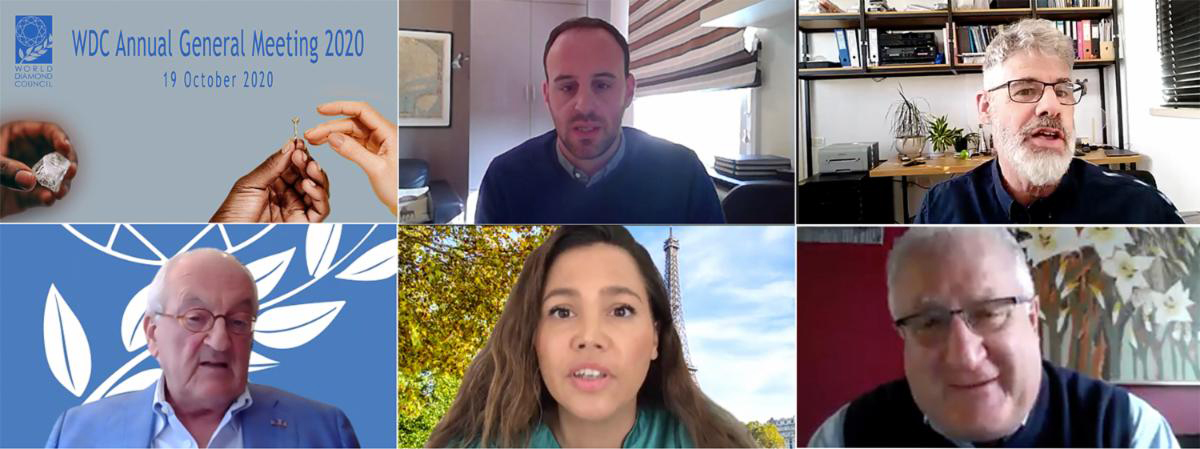
 |
|
| Home Technology / Education Events & News Archives Designs |
|
WDC’s 2020 AGM focuses on the latest KP developments and industry’s efforts to source responsibly, despite pandemic WDC President Edward Asscher lists seven essential principles of responsible sourcing, covering human rights, labor rights, the environment, anti-corruption, anti-money laundering, supporting grassroots development in the mining and production areas, and differentiating between natural and synthetic diamonds. 
Participants during the virtual 2020 WDC Annual General Meeting, clockwise from top, center: David Prager, Executive Vice President Corporate Affairs, De Beers Group; Edahn Golan, industry analyst and the panel moderator; Ronnie Vanderlinden, WDC Treasurer; Elodie Daguzan, WDC Executive Director; and Edward Asscher WDC President. Members of the World Diamond Council assembled for the organization’s Annual General Meeting on October 19, 2020, joined by invited guests, among them representatives of the governments involved in the Kimberley Process and members of civil society. In contrast to previous WDC AGMs, this gathering was not held in person but rather by videoconference, a consequence of the many travel restrictions in place worldwide because of the COVID-19 health crisis. The new format of the AGM allowed for an abbreviated 90-minute session, comprised of a keynote address by David Prager, Executive Vice President Corporate Affairs at the De Beers Group, on the industry’s role to meet the expectations of the changing consumer, and a panel discussion led by Edahn Golan, a noted industry analyst, with Mr. Prager and Mr. Asscher, the WDC President. It was followed by the more formal AGM agenda, with reports by the WDC President, WDC Executive Director Elodie Daguzan and WDC Treasurer Ronnie Vanderlinden. The dominant theme of the 2020 AGM was the industry’s obligation to maintain and grow consumer confidence in the sector. It focused on the critical role that institutional organizations like the KP and the WDC, through its System of Warranties, have in providing a backbone to this mission, particularly in a market that is being fundamentally impacted by the global pandemic. In his report to the AGM, Mr. Asscher spoke about the act of gifting a natural diamond as a symbol of love and appreciation for those who are closest to you. This is due to the emotional connection of consumers to diamonds, and it is a connection that is underpinned by trust. “Today’s consumers understand very well that loving relationships are so important in these difficult times,” the WDC President said. “Diamonds are still considered symbols of loving relationships but now consumers all over the world are asking for more. The key words today are sustainability, ethically sourced diamonds, and proof of respect for human rights. The WDC is key to setting those conditions, together with the KP member governments and the NGOs.” This sentiment was underscored in his keynote address by Mr. Prager. Recent developments, he said, “…have reinforced the importance of brands not only to take a stand, but for brands to take action. It can be demonstrated today that being a brand is more than just selling a product that consumers want. It is also about understanding what matters to those consumers and how your brands align with their values in a meaningful way.” Research today indicates that social purpose is the new status of luxury goods, Mr. Prager stressed, pointing out that consumers want the products they buy “not to be part of the problem, but rather part of the solution to important global issues.” The Kimberley Process Certification Scheme (KPCS) has played a critical role in defending the integrity of the diamond supply chain, Mr. Prager stated, but it would be incorrect to regard it as a complete solution. Explaining his point by way of a metaphor, he noted that a traffic light is an important element in regulating the movement of cars, but in and of itself it will not completely prevent speeding. Other solutions are required, like speed bumps and speed traps. In a similar way, he said, a regulatory mechanism like the KPCS must be supported in its protection of the diamond value chain by other systems, like the OECD Due Diligence Guidance for Responsible Supply Chains of Minerals from Conflict-Affected and High-Risk Areas, as well as the new WDC System of Warranties and the Responsible Jewellery Council (RJC) Code of Practices. Asked by the panel discussion moderator about the path forward for the KP, Mr. Asscher spoke about the introduction of Seven Principles in support of responsible sourcing at the KP. These, he said, include complying with international conventions related to human rights, labor rights, environmental practices, anti-corruption and anti-money laundering, as well as supporting the development of communities in the mining and production areas, and disclosing and differentiating natural and synthetic diamonds. “Those seven principles, if we are able to reach consensus at the KP, will have a remarkable impact on the influence and recognition of these topics as part of the whole KP system,” he said. |